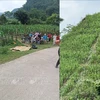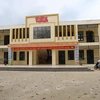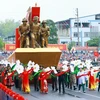 Hanoi has focused resources on infrastructure construction, especially transport infrastructure. (Photo: VNA)
Hanoi has focused resources on infrastructure construction, especially transport infrastructure. (Photo: VNA) Hanoi (VNA) – Hanoi has focused resources on infrastructure construction, especially transport infrastructure, with many important projects rolled out and put into service, contributing to ease traffic congestion in the capital city.
The investment aims to accelerate urbanisation and spur economic growth of Hanoi and the capital region, 15 years after expanding the city’s administrative boundaries.
Among the transport projects put in place over the past 15 years are the nearly 30-km Thang Long Boulevard opened to traffic on September 25, 2010, connecting Hanoi’s centre and its western gateway, and the 13.05km Cat Linh-Ha Dong metro line operational since November 6, 2021.
Notably, the 65-km Belt Road 3 runs through nine districts in Hanoi and links the capital city to all expressways and other regions. Meanwhile, the elevated section of Belt Road 2 from Nga Tu So to Vinh Tuy became operational on January 11, 2023. Belt Road 2 spans eight Hanoi districts.
The Phap Van-Cau Gie route received the green light to be upgraded to an expressway as part of the eastern wing of the North-South Expressway in 2013.
Alongside numerous roads, bridges, tunnels and intersections have also been constructed, including the Vinh Tuy Bridge, stretching 5.8 km across the Red River, and connecting Hai Ba Trung and Long Bien districts. Its first phase was put into operation on September 26, 2010, while the second is scheduled for September 2023.
The Dong Tru Bridge, whose construction began on September 10, 2006, and inaugurated on October 9, 2014, serves as a pivotal connection between Dong Anh and Long Bien districts. With a total length of 1,240m, it is regarded as the widest river-crossing bridge in Vietnam.
The Le Van Luong underpass project, commenced in October 2020 and completed one year later, has significantly contributed to reducing traffic pressure for the Le Van Luong route and its surrounding areas, while meeting transportation demand between the centre and the northern part of Hanoi. The underpass is 475m long and 7.5m wide, with two lanes for vehicles.
Deputy Director of the municipal Department of Transport Tran Huu Bao pointed out that the number of personnel vehicles is increasing sharply in Hanoi given limited routes, leading to serious traffic congestion.
Therefore, Hanoi will pay more attention to transport infrastructure development in a concerted fashion in line with the planning scheme approved by the Prime Minister, with priority given to belt roads like Belt Road 4 in order to expand its development space, along with key routes such as National Highways 1 and 6, and river-crossing bridges.
By 2030, Hanoi will strive to complete expressways, highways, radial roads, provincial roads and belt roads, including seven belt roads linking the city and provinces, as well as its centre and satellite urban areas.
Currently, Hanoi has seven radial roads with a total length of 111.32 km running through the city, along with eight radial national highways with a total length of 244.58 km. Meanwhile, the construction of 132.26 km out of the planned 285.46 km of seven ring roads has been completed.
The city has also paid great attention to public transportation. As of July 2023, the bus public transport network in Hanoi had had 154 routes, with 2,279 vehicles. In 2022, the volume of public passenger transport by bus reached 340 million passengers, of which 334 million passengers used subsidized buses.
Vice Director of the Public Transport Management Centre of Hanoi Thai Ho Phuong said that currently, the bus transport network of Hanoi has reached all 30 districts and townships, and 512 out of 579 communes, wards and towns as well as seven nearby localities./.






















